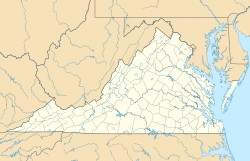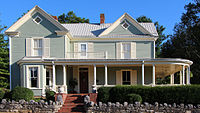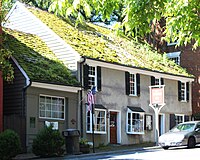Abingdon Historic District is a national historic district located at Abingdon, Washington County, Virginia. The district encompasses 145 contributing buildings, 2 contributing site, and 13 contributing structures in the town of Abingdon. It includes a variety of residential, commercial, and institutional buildings dating from the late-18th century to the mid-20th century. Notable contributing resources include Sinking Spring Cemetery, William King High School (1913), General Francis Preston House (1832), Martha Washington Inn, Barter Theatre, the Virginia House, Alexander Findlay House (1827), Gabriel Stickley House (c. 1830), Ann Berry House (c. 1830), Washington County Courthouse (1868), Rev. Charles Cummings House (c. 1773), and James Fields House (1857). Located in the district and separately listed are the Abingdon Bank and Dr. William H. Pitts House.[3][4][5][6]
Abingdon Historic District | |
 Martha Washington Inn, June 2007 | |
| Location | Both sides of Main St. between Cummings and Deadmore Sts.; Roughly bounded by Russell Rd. and Jackson St., Whites Mill Rd., E. Main and E. Park and W. Main Sts., and Academy Dr., Abingdon, Virginia |
|---|---|
| Coordinates | 36°42′33″N 81°58′18″W / 36.70917°N 81.97167°W |
| Area | 159.5 acres (64.5 ha) |
| Built | 1778 |
| Architectural style | Colonial Revival, Bungalow/craftsman, Queen Anne |
| NRHP reference No. | 70000831, 86002193 (Boundary Increase)[1] |
| VLR No. | 140-0037, 140–0039 |
| Significant dates | |
| Added to NRHP | February 26, 1970, September 17, 1986 (Boundary Increase) |
| Designated VLR | December 2, 1969, April 15, 1986[2] |

It was listed on the National Register of Historic Places in 1970, with a boundary increase in 1986.[1]
| Name | Address | Year Built | Architectural Style | Comments |
| Alexander Findlay House | 101 Valley St., N.E. | 1827 | Federal | This is the oldest surviving building on Valley Street[4] |
| Gabriel Stickley House | 239 Valley St., N.E. | c. 1830 | Federal | Amongst the oldest surviving buildings on Valley Street[4] |
| Daniel Trigg House | 210 Valley St., N.E. | Early to mid 19th Century | Vernacular | Representative of mid 1800s middle class architecture[4] |
| Daniel Musser House | 247 Valley St., N.E. | 1869 | Italianate | This house is one of several on Valley Street that was considered "fashionable", representing prosperity after the Civil War[4] |
| David G. Thomas House | 153 Valley St., N.E. | 1870s | Italianate | This house is one of several on Valley Street that was considered "fashionable", representing prosperity after the Civil War[4] |
| 185 Valley St., N.E. | 1900 | Vernacular | Representative of mid to late 1800s middle class architecture[4] | |
| 152 Valley St., N.E. | 1890s | Vernacular | Representative of late to mid 1800s middle class architecture[4] | |
| 315 Valley St., N.E. | 1890s | Vernacular | Representative of late to mid 1800s middle class architecture[4] | |
| 337 Valley St., N.E. | 1890s | Modified Queen Anne | ||
| 164 Valley St., N.W. | 1890s | Modified Queen Anne | ||
| 125 Valley St., N.W. | 1920s | Colonial Revival | ||
| 274 Valley St., N.W. | c. 1900 | Modified Queen Anne | ||
| Dr. William H. Pitts House | 247 E. Main St. | 1854 | Greek Revival. Its exterior stucco walls are unique to the Abingdon Historic District [5] | Listed on the National Register of Historic Places in 2002[5] |
| Washington County Courthouse | N.W. corner of N. Court and E. Main St. | 1868 | Building has four Greek Doric Columns, and an Italianate cornice and tower. | Three earlier courthouses stood on this site, the first constructed in 1800. Present building replaced previous that was burned during the Civil War.[7] |
| Abingdon Bank | 225 E. Main St., Abingdon, VA | c. 1845 | Greek revival/Late Victorian architecture | Originally housed a resident cashier and his family in one section, and bank, counting room, and vault in the other.[6] |
| Fields-Penn House | 208 W. Main St. | 1860 | Georgian proportions and Greek revival elements[8] | In 1971, the Penn family sold the home to the Penn House Preservation Foundation, which later conveyed it to the Town of Abingdon. The William King Regional Arts Center managed the home beginning in 1995. Today, the Fields-Penn 1860 House museum is operated by the Town of Abingdon[8] |
| The Tavern | 222 E. Main St. | 1779 | This is the oldest building in Abingdon. During the past two centuries, The Tavern has served as a tavern, bank, bakery, general store, cabinet shop, barber shop, private residence, post office, antique shop and restaurant. It also served as a hospital for wounded Confederate and Union soldiers during the Civil War.[9] | |
| Sinking Spring Presbyterian Church | 136 E. Main St. | 1851 | Greek Revival | First located at the Sinking Spring Cemetery in the early 1700s, the first Presbyterian Church was a log structure. The congregation was moved to what is now known as the Barter Theater in 1833. In 1837 the church divided, and one group moved to the present location[10] |
| Barter Theater | 127 W. Main St. | Early-mid 1800s | Unclassified | The earliest theatrical event known to occur here was a production of the Virginian on January 14, 1876. In 1890, the Sons of Temperance transferred the building's title to the Town of Abingdon, to be used as a town hall for the benefit of the citizenry. It opened as a theater on June 10, 1933. It is one of the longest-running professional theaters in the nation.In 1933, when the country was in the middle of the Great Depression, most patrons were not able to pay the full ticket price. Robert Porterfield, founder of the theatre, offered admission by letting the local people pay with food goods, hence the name "Barter".[11] |
| Martha Washington Inn | 150 W. Main St. | 1832 | Unclassified | It was built as a private residence for General Francis Preston and Sarah Buchanan Preston and their nine children. The original brick residence still comprises the central structure of The Martha Washington Hotel and the original living room of the Preston family is now the main lobby of the hotel. In 1858 the Preston family home was purchased for the mansion to become an upscale college for young women. The school was named Martha Washington College. The college operated for over 70 years through the years of the Civil War and the Great Depression. During the Civil War the grounds became training barracks for the Washington Mounted Rifles. Union and Confederate troops were involved in frequent skirmishes in and around Abingdon with the College serving as a makeshift hospital for the wounded, both Confederate and Union. The Martha was closed in 1932. In 1935, The Martha Washington opened as a hotel[12] |
References edit
- ^ a b "National Register Information System". National Register of Historic Places. National Park Service. July 9, 2010.
- ^ "Virginia Landmarks Register". Virginia Department of Historic Resources. Archived from the original on September 21, 2013. Retrieved June 5, 2013.
- ^ Virginia Historic Landmarks Commission Staff (November 1969). "National Register of Historic Places Inventory/Nomination: Abingdon Historic District" (PDF). Virginia Department of Historic Resources. and Accompanying photo Archived 2013-10-15 at the Wayback Machine and Accompanying map Archived 2016-12-24 at the Wayback Machine
- ^ a b c d e f g h i Division of Historic Landmarks Staff (March 1986). "National Register of Historic Places Inventory/Nomination: Abingdon Historic District (Boundary Increase)" (PDF). Virginia Department of Historic Resources. Archived from the original (PDF) on October 15, 2013. Retrieved October 12, 2013. and Accompanying photo Archived 2013-10-15 at the Wayback Machine and Accompanying map Archived 2016-12-24 at the Wayback Machine
- ^ a b c Ashley L. Robbins and Susan G. Deihl (March 2001). "National Register of Historic Places Inventory/Nomination: Dr. William H. Pitts House" (PDF). Virginia Department of Historic Resources. Archived from the original (PDF) on October 15, 2013. Retrieved August 19, 2015. and Accompanying photo Archived 2013-10-15 at the Wayback Machine
- ^ a b Virginia Historic Landmarks Commission Staff (June 1969). "National Register of Historic Places Inventory/Nomination: Abingdon Bank" (PDF). Virginia Department of Historic Resources. Archived from the original (PDF) on October 15, 2013. Retrieved August 19, 2015. and Accompanying photo Archived 2013-10-15 at the Wayback Machine
- ^ "Courthouses of Virginia". Retrieved January 27, 2016.
- ^ a b "About Us". The Fields-Penn House. Retrieved January 27, 2016.
- ^ "History – The Tavern Restaurant – Abingdon, Virginia". Retrieved January 27, 2016.
- ^ "Sinking Spring Presbyterian Church History". Retrieved January 27, 2016.
- ^ "Home – Barter Theatre". Barter Theatre. Retrieved January 27, 2016.
- ^ "The History of the Martha Washington Inn & Spa". Retrieved January 27, 2016.






















